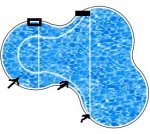okay, so i asked this before, and i sounded like a crazy person. i figured i'd fuel the fire some more.
i think i need 3 settings:
1. chlorinate the pool only, no heat pump.
2. chlorinate the pool while running the heat pump on low speed to slightly heat pool.
3. chlorinate the pool while running the heat pump like a banshee (60gpm is its optimal flow rate).
i want to do this in a way where i maximize electrical savings. when i asked the pb what my head loss was, her only response was that no one in 20 years ever asked such a question. she asked why i cared. i said it was so that i could use the pump curve to pick the most energy efficient rpm for each of those 3 settings.
i do not have a check valve installed, so i can't retrofit a flowmeter. but i suppose i could install some pressure gauges on the pump to measure pressure/suction to determine head loss?
or am i really being crazy and i should just run it at 2400rpm like the pb says?
i have a jandy VSFHP165JEP and a truclear swg.
- - - Updated - - -
she was going on about needing to turn over the water at least once a day given the pool's in full sun, to which i responded that i only intended to run the pump long enough to filter the water or keep the free chlorine at the desired level, whichever took longer, and intended to do so at the lowest possible speed, hopefully reducing the swg output to a lesser output level that runs for a longer time (maybe putting less stress on it?).
i think i need 3 settings:
1. chlorinate the pool only, no heat pump.
2. chlorinate the pool while running the heat pump on low speed to slightly heat pool.
3. chlorinate the pool while running the heat pump like a banshee (60gpm is its optimal flow rate).
i want to do this in a way where i maximize electrical savings. when i asked the pb what my head loss was, her only response was that no one in 20 years ever asked such a question. she asked why i cared. i said it was so that i could use the pump curve to pick the most energy efficient rpm for each of those 3 settings.
i do not have a check valve installed, so i can't retrofit a flowmeter. but i suppose i could install some pressure gauges on the pump to measure pressure/suction to determine head loss?
or am i really being crazy and i should just run it at 2400rpm like the pb says?
i have a jandy VSFHP165JEP and a truclear swg.
- - - Updated - - -
she was going on about needing to turn over the water at least once a day given the pool's in full sun, to which i responded that i only intended to run the pump long enough to filter the water or keep the free chlorine at the desired level, whichever took longer, and intended to do so at the lowest possible speed, hopefully reducing the swg output to a lesser output level that runs for a longer time (maybe putting less stress on it?).



